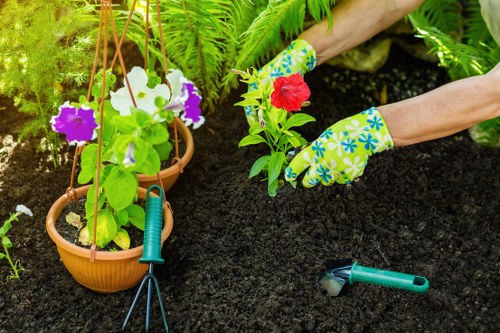Mastering Hedge Trimming in Cleaners E1: A Comprehensive Guide

Introduction to Hedge Trimming
Maintaining well-trimmed hedges is essential for enhancing the aesthetic appeal and health of your garden. In Cleaners E1, homeowners and gardening enthusiasts alike seek effective hedge trimming techniques to keep their landscapes looking pristine.
Proper hedge trimming not only beautifies your property but also promotes the growth and longevity of your bushes. Whether you're a seasoned gardener or a beginner, understanding the fundamentals of hedge trimming is crucial.
In this guide, we will delve into the best practices, tools, and tips for achieving perfectly trimmed hedges in Cleaners E1.

Benefits of Regular Hedge Trimming
Regular hedge trimming offers numerous advantages that go beyond mere aesthetics. Here are some key benefits:
- Healthier Plants: Trimming removes dead or diseased branches, allowing the plant to focus its energy on healthy growth.
- Controlled Growth: Keeps hedges at a manageable size, preventing them from becoming overgrown and unruly.
- Enhanced Appearance: A well-trimmed hedge adds structure and elegance to your garden, increasing curb appeal.
- Increased Sunlight Exposure: Pruning dense foliage allows more sunlight to reach the inner parts of the plant, promoting overall growth.
Emphasizing the importance of regular maintenance can significantly improve the longevity and beauty of your hedges.
Moreover, well-maintained hedges can serve as effective privacy screens, offering seclusion and security for your outdoor spaces.

Essential Tools for Hedge Trimming
Having the right tools is paramount for efficient and effective hedge trimming. Below is a list of essential equipment every gardener in Cleaners E1 should have:
- Hedge Trimmers: Available in manual, electric, and gas-powered varieties, hedge trimmers are indispensable for cutting through thick branches with ease.
- Pruning Shears: These are perfect for precision cuts on smaller branches and shaping the finer details of your hedges.
- Loppers: Ideal for trimming larger branches that are beyond the capacity of standard pruning shears.
- Gloves: Protect your hands from thorns and sharp branches while ensuring a firm grip.
- Safety Goggles: Essential for protecting your eyes from flying debris during trimming.
Investing in quality tools can make the hedge trimming process smoother and safer, ultimately leading to better results.
Regular maintenance of your tools, such as sharpening blades and proper storage, extends their lifespan and ensures optimal performance during each trimming session.

Step-by-Step Hedge Trimming Guide
1. Assess Your Hedges
Before commencing any trimming, take the time to evaluate the current state of your hedges. Look for signs of disease, pest infestation, or uneven growth patterns.
Identify the desired shape and height you wish to achieve, keeping in mind the natural growth tendencies of the hedge species.
Tips for Assessment:
- Check for symmetry in both sides of the hedge.
- Look for any dead or damaged branches that need immediate removal.
- Consider the overall landscape and how the hedges fit into the garden design.
2. Prepare Your Tools
Ensure all your trimming tools are clean, sharp, and in good working condition. Sharpen blades as needed to make precise cuts.
Wear appropriate protective gear, including gloves and safety goggles, to prevent injuries during the trimming process.
Safety Precautions:
- Always wear protective clothing to safeguard against scratches and debris.
- Ensure your work area is clear of any obstacles or hazards.
- Use stable footing to prevent slips or falls while trimming at heights.
3. Start Trimming
Begin by trimming the sides of the hedge, following the natural contour of the plant. Use smooth, even strokes to achieve a uniform shape.
Move on to trimming the top of the hedge, ensuring it slopes slightly outward to allow sunlight and air circulation.
Trimming Techniques:
- Cut at a slight angle to promote water runoff.
- Step back periodically to assess the symmetry and make adjustments as needed.
- Avoid cutting too much at once; it’s better to trim incrementally to maintain plant health.
4. Clean Up
After trimming, collect and dispose of all clippings to prevent the spread of pests and diseases. Clean your tools thoroughly to remove any plant residue.
Regular clean-up not only keeps your garden tidy but also prepares your tools for future use.

Common Hedge Trimming Mistakes to Avoid
Even with the best intentions, certain mistakes can hinder the effectiveness of your hedge trimming efforts. Here are some common pitfalls to watch out for:
- Over-Trimming: Removing too much foliage can stress the plant, making it more susceptible to diseases.
- Improper Timing: Trimming hedges at the wrong time of year can disrupt their natural growth cycles.
- Uneven Cuts: Inconsistent trimming can result in an unbalanced and unattractive appearance.
- Neglecting Plant Health: Failing to address underlying health issues can lead to poor hedge growth.
Being mindful of these common mistakes ensures that your hedge trimming efforts lead to healthy and beautiful plants.
Additionally, seeking professional advice or training can help you refine your trimming techniques and achieve better results.
Contact us today to learn more about our expert hedge trimming services in Cleaners E1 and keep your garden looking its best.
Choosing the Right Time for Hedge Trimming
The timing of your hedge trimming plays a crucial role in the health and appearance of your hedges. Understanding the optimal seasons for trimming can lead to more effective results.
Generally, the best times to trim hedges are during the late winter or early spring, just before the new growth begins. This timing encourages robust growth and helps maintain the desired shape.
Seasonal Considerations:
- Spring: Ideal for promoting new growth and shaping young hedges.
- Summer: Suitable for light maintenance and controlling excessive growth.
- Autumn: Can be used to trim back hedges before the onset of winter, but avoid heavy trimming.
- Winter: Generally not recommended unless dealing with specific issues like removing dead wood.
Adjust your trimming schedule based on the specific needs of your hedge species and local climate conditions in Cleaners E1.
Effective timing ensures that your hedges remain healthy and resilient throughout the year.
Hedge Trimming Techniques for Different Hedge Types
Different hedge species require tailored trimming techniques to maintain their unique shapes and health. Here are some guidelines for various types of hedges:
Formal Hedges
Formal hedges, such as boxwood, benefit from precise and structured trimming. Use sharp hedge trimmers to achieve clean lines and uniform shapes.
Techniques:
- Trim regularly to maintain the desired form.
- Use string lines as guides for straight cuts.
- Avoid heavy pruning, which can damage the plant.
Informal Hedges
Informal hedges, like yew or privet, allow for more natural shapes. Trimming should focus on maintaining a tidy appearance without enforcing strict lines.
Techniques:
- Prune lightly to encourage bushier growth.
- Shape the hedge based on its natural growth pattern.
- Remove any encroaching branches to prevent overcrowding.
Evergreen Hedges
Evergreen hedges, such as holly or laurel, require specific trimming practices to preserve their foliage and health.
Techniques:
- Trim during the late winter or early spring.
- Remove any dead or diseased branches promptly.
- Ensure good air circulation by thinning out dense areas.
Adapting your trimming approach to the specific hedge type ensures optimal growth and a beautiful appearance.
Understanding the unique needs of each hedge species in Cleaners E1 allows you to implement effective trimming strategies tailored to your garden.
Maintaining Hedge Health Post-Trimming
Proper hedge trimming is just one aspect of maintaining healthy hedges. Post-trimming care is equally important to ensure your plants thrive.
Watering
Ensure your hedges receive adequate water, especially during dry periods. Proper hydration supports recovery and new growth after trimming.
- Water deeply but infrequently to encourage deep root growth.
- Avoid overwatering, which can lead to root rot and other issues.
- Mulch around the base to retain moisture and regulate soil temperature.
Fertilizing
Applying the right fertilizers can provide essential nutrients that promote healthy growth and resilience.
- Choose a balanced fertilizer suitable for your hedge type.
- Follow application instructions carefully to avoid over-fertilization.
- Consider organic options to enhance soil health naturally.
Pest and Disease Control
Monitor your hedges regularly for signs of pests or diseases. Early detection and treatment can prevent severe damage.
Implement integrated pest management practices to maintain a healthy garden ecosystem.
Book your service now to ensure your hedges remain healthy and vibrant year-round with our expert care in Cleaners E1.
Eco-Friendly Hedge Trimming Practices
Adopting eco-friendly practices in hedge trimming not only benefits your garden but also the broader environment.
Sustainable Tool Usage
Opt for energy-efficient tools such as electric or battery-powered hedge trimmers to reduce your carbon footprint.
- Maintain tools regularly to ensure they operate efficiently.
- Recycle or responsibly dispose of old equipment.
- Consider manual trimmers for smaller hedges to minimize energy use.
Waste Management
Properly managing green waste is crucial for environmental sustainability.
- Compost plant clippings to create nutrient-rich soil amendments.
- Use green waste collection services available in Cleaners E1.
- Reduce waste by trimming regularly and preventing excessive clippings.
Promoting Biodiversity
Encourage a diverse ecosystem by preserving some natural branches and leaves, providing habitat for beneficial insects and wildlife.
Implementing these eco-friendly practices helps create a sustainable and thriving garden environment.
Hiring Professional Hedge Trimming Services
While DIY hedge trimming is feasible, professional services offer expertise and efficiency that can enhance the quality of your garden maintenance.
Advantages of Professional Services
- Expertise: Trained professionals understand the specific needs of different hedge species.
- Efficiency: Professionals have access to advanced tools and techniques, completing tasks faster.
- Safety: Trained individuals follow safety protocols, reducing the risk of accidents.
- Consistent Results: Professional trimming ensures a uniform and aesthetically pleasing appearance.
Choosing the Right Service Provider
When selecting a hedge trimming service in Cleaners E1, consider the following factors:
- Experience and reputation in the local community.
- Range of services offered, including maintenance and specialized trimming.
- Customer reviews and testimonials.
- Pricing and service packages that fit your budget.
- Environmental practices and commitment to sustainability.
Investing in professional services can save you time and ensure your hedges receive the best possible care.
Don't wait any longer to achieve the garden of your dreams. Contact us today for top-notch hedge trimming services in Cleaners E1.
Conclusion: Achieving Perfect Hedges in Cleaners E1
Hedge trimming is a vital aspect of garden maintenance that requires knowledge, the right tools, and consistent effort. By following the guidelines outlined in this guide, you can ensure your hedges remain healthy, attractive, and well-shaped.
Remember to assess your hedges regularly, use appropriate trimming techniques, and adopt eco-friendly practices to promote sustainability.
Whether you choose to undertake hedge trimming yourself or hire professional services, the key is to stay informed and proactive in your garden care routine.
Book your service now and let our experts in Cleaners E1 help you maintain beautiful and thriving hedges all year round.


